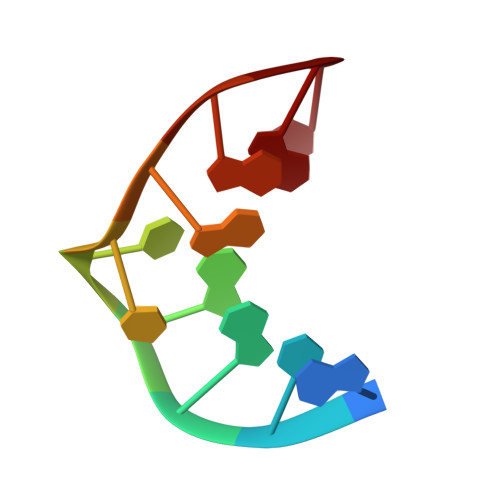Experimental Demonstration of T:(G:G:G):T Hexad and T:A:A:T Tetrad Alignments within a DNA Quadruplex Stem
Webba da Silva, M.(2005) Biochemistry 44: 3754-3764
- PubMed: 15751952
- DOI: https://doi.org/10.1021/bi0478190
- Primary Citation of Related Structures:
1XCE - PubMed Abstract:
A template-based approach was used to design unprecedented architectural motifs into a known DNA framework. The structure formed by the sequence d(GCGGTTGGAT) in 0.1 M Na(+) solution has been determined using molecular dynamics simulations constrained by distance and dihedral restraints derived from NMR experiments. The molecular topology has been previously observed for the sequence d(GCGGTGGAT) (Webba da Silva, M. (2003) Biochemistry 42, 14356-65). Insertion of a single thymine into the double chain reversal formed by the segment GGTGG results in the unprecedented experimental demonstration of a T:(G:G:G:G):T hexad. The bi-stranded hexad results from the pairing alignment of two G(T-G) triads. Each triad results from recognition of the sheared edge of a guanine by the Watson-Crick edge of a thymine of the segment GGTTGG. The alignment is stabilized by base-stacking of the thymine to the sugar pucker of the preceding thymine. The latter is involved in formation of the T:A:A:T tetrad alignment by forming a hydrogen bond with the free amino proton of a Watson-Crick aligned A:A mispair. We have thus established that residues in double chain reversal loops linking juxtaposed tetrads of a quadruplex stem may facilitate formation of yet unknown hydrogen bond alignments. By employing a systematic approach analysis of sequence motifs appearing in double chain reversals, bridging tetrad layers should allow for the prediction of topologies and architectural motifs appearing in biologically relevant genomic regions.
- Department of Medicine, Duke University Medical Center, Durham, North Carolina 27710, USA. mateus@webbas.org
Organizational Affiliation:
















